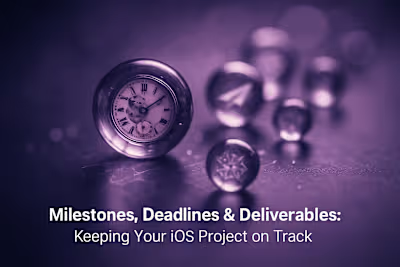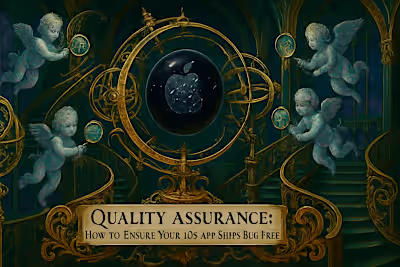Resume Red Flags: 7 Signs You're Looking at a Phony iOS Developer

Resume Red Flags: 7 Signs You're Looking at a Phony iOS Developer
Vague or Buzzword-Heavy Project Descriptions
Look for STAR Method Application
The 'We' vs. 'I' Problem
Inconsistent Timelines and Experience Inflation
Cross-Referencing with LinkedIn
Job Hopping vs. Career Progression
Lack of Quantifiable Achievements
Examples of Strong Metrics
Generic, Non-Specific Skill Lists
Asking Probing Questions
What a Strong iOS Developer Resume Looks Like
References
Resume Red Flags: 7 Signs You're Looking at a Phony iOS Developer
When hiring an iOS developer, the resume is your first filter. But a slick document can easily hide a lack of real-world skills. Learning to spot the warning signs is crucial to avoid a bad hire. This guide will walk you through the most common red flags that separate genuine talent from pretenders.
Once you've screened the resumes, the next step is digging into their portfolio, a critical step to verify their practical abilities. Whether you're looking to hire the best iOS developers for your startup or enterprise project, knowing what to watch for can save you time, money, and headaches down the road.
Vague or Buzzword-Heavy Project Descriptions
You've seen them before. Resumes packed with phrases like "leveraged cutting-edge technologies" or "synergized cross-functional teams." These impressive-sounding buzzwords often mask a lack of actual experience. A real iOS developer can describe their work in clear, concrete terms that paint a picture of what they actually did.
Take this example. A phony resume might say: "Utilized Swift and innovative frameworks to create revolutionary mobile solutions." Compare that to a genuine developer who writes: "Built a real-time chat feature in Swift using WebSocket connections, reducing message delivery time from 3 seconds to under 200ms."
See the difference? One is vague fluff. The other shows specific knowledge, actions taken, and measurable results. When reviewing resumes, pay close attention to how candidates describe their projects. If they can't explain what they built or how they solved problems, that's your first red flag.
Look for STAR Method Application
The STAR method (Situation, Task, Action, Result) is how experienced professionals naturally describe their work. They set the scene, explain what needed to be done, describe their specific actions, and share the outcome. Vague resumes often lack one or more of these elements.
Here's what to look for:
Situation: "Our e-commerce app was experiencing 15% cart abandonment due to slow checkout" Task: "I was assigned to optimize the payment flow" Action: "Refactored the payment module using async/await patterns and implemented local caching" Result: "Reduced checkout time by 40% and cart abandonment dropped to 8%"
If a resume is missing these concrete details, especially the results, you're likely looking at someone who either didn't do the work or doesn't understand its impact. Real developers remember the problems they solved because they lived through the late nights fixing them.
The 'We' vs. 'I' Problem
Team collaboration is essential in iOS development. But when every accomplishment starts with "we," it raises questions about individual contribution. While it's good to see team players, you need to know what the candidate personally brought to the table.
Watch for patterns like:
"We developed a new app that gained 100K downloads"
"Our team improved app performance"
"We implemented new features"
These statements tell you nothing about the candidate's role. A strong resume balances team achievements with individual contributions:
"Led the implementation of push notifications while collaborating with the backend team"
"I designed the app's data persistence layer, which the team then integrated with the UI"
"Personally optimized image loading, contributing to our team's 30% performance improvement goal"
Inconsistent Timelines and Experience Inflation
Career timelines tell a story. When that story doesn't add up, you've found another red flag. Look for unexplained gaps, overlapping positions, or job titles that seem too senior for the candidate's experience level.
A 25-year-old claiming to be a "Senior iOS Architect" with "10 years of experience" should raise eyebrows. iOS development as we know it started with the iPhone SDK in 2008. Do the math on their claims.
Common timeline red flags include:
Multiple "senior" positions within the first 2-3 years of their career
Vague date ranges like "2019-2021" instead of specific months
Gaps between jobs with no explanation
Overlapping full-time positions at different companies
Cross-Referencing with LinkedIn
LinkedIn is your fact-checking friend. A candidate's online presence should match their resume. When it doesn't, you've caught them in a lie. Here's what to check:
First, see if they even have a LinkedIn profile. In 2024, a developer without any online presence is suspicious. They should at least have LinkedIn, if not GitHub or a personal website.
Next, compare the details:
Do the job titles match?
Are the employment dates the same?
Is the project description consistent?
Do they have endorsements or recommendations?
A sparse profile with no connections, no photo, and minimal information is a red flag. Real developers network, share knowledge, and build their professional presence online. If their LinkedIn was clearly created just for this job application, proceed with caution.
Job Hopping vs. Career Progression
Not all job changes are bad. The tech industry moves fast, and developers often change roles for better opportunities. But there's a difference between strategic moves and chronic job hopping.
Healthy career progression looks like:
2-3 years at each position
Clear growth in responsibilities
Logical moves between companies
Increasing technical complexity
Red flag patterns include:
Six jobs in three years
Lateral moves with no growth
Leaving companies just before annual reviews
No position lasting more than 8 months
Ask yourself: Does this person's career tell a story of growth? Or does it look like they're running from something?
Lack of Quantifiable Achievements
Numbers don't lie. That's why fake resumes avoid them. A developer who says they "improved app performance" without specifics is hiding something. Real achievements come with metrics.
Strong iOS developers track their impact. They know their code reduced crash rates by 25% or that their optimization saved 2MB of app size. They remember because they fought for those improvements.
Compare these two statements:
Weak: "Worked on app optimization and bug fixes"
Strong: "Reduced app launch time from 4.2 to 1.8 seconds by implementing lazy loading and optimizing asset compression"
The second one shows real work. It demonstrates understanding of the problem, the solution, and the measurable impact. If a resume lacks these specifics across multiple roles, the candidate likely lacks real experience.
Examples of Strong Metrics
Here's what quantifiable achievements look like for iOS developers:
Performance metrics:
"Improved app startup time by 60% through code optimization"
"Reduced memory footprint by 30MB by implementing efficient image caching"
"Achieved 99.8% crash-free sessions, up from 97.2%"
User engagement metrics:
"Increased daily active users by 25% after implementing push notifications"
"Improved app store rating from 3.2 to 4.6 stars"
"Reduced user churn by 15% through UX improvements"
Development efficiency metrics:
"Cut build time by 40% by modularizing the codebase"
"Reduced code review time by implementing automated testing, catching 80% of bugs pre-review"
"Decreased feature delivery time by 30% through reusable component library"
If a candidate can't provide similar metrics, they either didn't measure their work (a red flag itself) or didn't do work worth measuring.
Generic, Non-Specific Skill Lists
We've all seen them. Resumes with skill sections that read like an iOS development textbook: "Swift, Objective-C, Xcode, UIKit, SwiftUI, Core Data, Core Animation, ARKit, CloudKit, HealthKit..."
Anyone can copy a list of technologies from a job posting. The question is: can they actually use them? A real developer's skills section tells a story about their expertise, not just what they've heard of.
Watch for these warning signs:
Every possible iOS framework listed
No indication of proficiency level
Missing fundamental skills while claiming advanced ones
Outdated technologies mixed with cutting-edge ones
A genuine developer might write: "Expert in Swift and UIKit with 5 years of experience. Intermediate SwiftUI knowledge from two production apps. Learning Combine framework through side projects."
Asking Probing Questions
When you spot a suspicious skill list, prepare questions that dig deeper. Generic answers reveal fake expertise quickly.
For Core Data claims, ask: "Tell me about a complex data migration you handled in Core Data. What was your approach?"
A real answer sounds like: "We needed to migrate 50,000 user records when we changed our data model. I implemented a progressive migration that ran in the background, processing batches of 500 records to avoid blocking the UI. Used NSBatchUpdateRequest for efficiency and added progress tracking so users knew what was happening."
A fake answer sounds like: "I used Core Data to store data in the app. It was very efficient and worked well."
For SwiftUI experience, try: "What's been your biggest challenge with SwiftUI's state management?"
Someone with real experience might say: "Managing complex state across multiple views was tricky. I started with @State and @Binding but found myself passing too many parameters. Switched to @StateObject with ObservableObject pattern for shared state, which cleaned up the code significantly."
What a Strong iOS Developer Resume Looks Like
After all these red flags, let's paint a picture of what you should be looking for. A strong iOS developer resume tells a clear story of growth, impact, and genuine expertise.
It starts with a concise summary that highlights their specialty. Not "experienced iOS developer" but "iOS developer specializing in healthcare apps with expertise in HealthKit integration and HIPAA compliance."
The experience section reads like a collection of success stories. Each role shows progression, specific contributions, and measurable results. You can trace their journey from junior developer fixing bugs to senior developer architecting solutions.
Projects are described with context. They explain the problem, their approach, the technologies used, and the outcome. You understand not just what they built, but why it mattered.
The skills section is honest and organized. Primary skills are separated from secondary ones. They might list "Expert: Swift, UIKit, REST APIs" and "Familiar: SwiftUI, Combine, GraphQL." This shows self-awareness and honesty.
Most importantly, there are links to their work. A GitHub profile, App Store links, or a portfolio website. Real developers are proud of their work and want to show it off. They know their code speaks louder than any resume.
Remember, hiring the wrong developer costs more than just their salary. It delays your project, frustrates your team, and can damage your product. Take the time to spot these red flags. Ask the tough questions. Verify the claims.
The best developers make it easy to verify their skills because they have nothing to hide. Their resumes are clear, specific, and backed by evidence. When you find one, you'll know it. The red flags will be absent, replaced by green lights pointing to genuine expertise and real accomplishments.
References
Like this project
Posted Jul 6, 2025
Don't get fooled by a polished resume. Learn how to spot the key red flags that expose a fake iOS expert and save your project from disaster.









